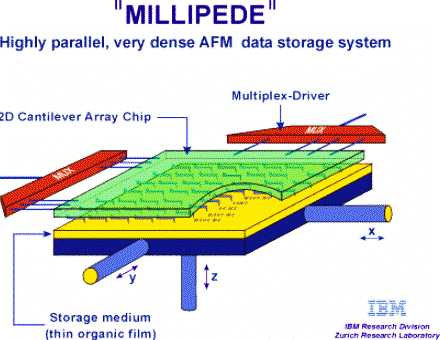High-density data storage uses atomic-force microscope technology
In a report to be published in the Nov. 13 issue of the journal Applied Physics Letters, Peter Vettiger and colleagues at IBM's research laboratory in Zurich describe a 32x32 array of micromechanical levels that function as AFM sensors to read and write data as small indentations in a thin polymer film made of poly(methyl methacrylate), or PMMA. They have achieved batch fabrication of the cantilever arrays, which work in parallel.

The new system can write data with a density of 400 to 500 Gbit/in2, some 10 times greater than is possible with current magnetic hard drive technology. Writing data is accomplished when a heated cantilever bores a small hole, 30-40 nm across, in the underlying polymer film.
One limitation of the AFM data storage method is that it is rather slow. To speed things up, the IBM team has developed what it calls "millipede" technology, in which an array of more than 1000 AFM probes reads and writes the information. Data density as high as 200 Gbit/in2, and potentially much higher, are said to be possible with this system, which has a data rate of 32 kbit/sec. That speed is slower than most current computers, but the Zurich researchers believe they can eventually boost the rates to the Gbit/sec level when they clear up bottlenecks with computer interfaces.
The likely first applications for this new data storage system would be in cell phones, the IBM team says. The reason is that in such devices space, but not so much speed, is the prime consideration.
For more information, contact Peter Vettiger, IBM Research, Zurich Research Laboratory, at pv@zurich.ibm.com.
Edited by Gordon Graff
Managing Editor, Laboratory Network.com
ggraff@vertical.net
